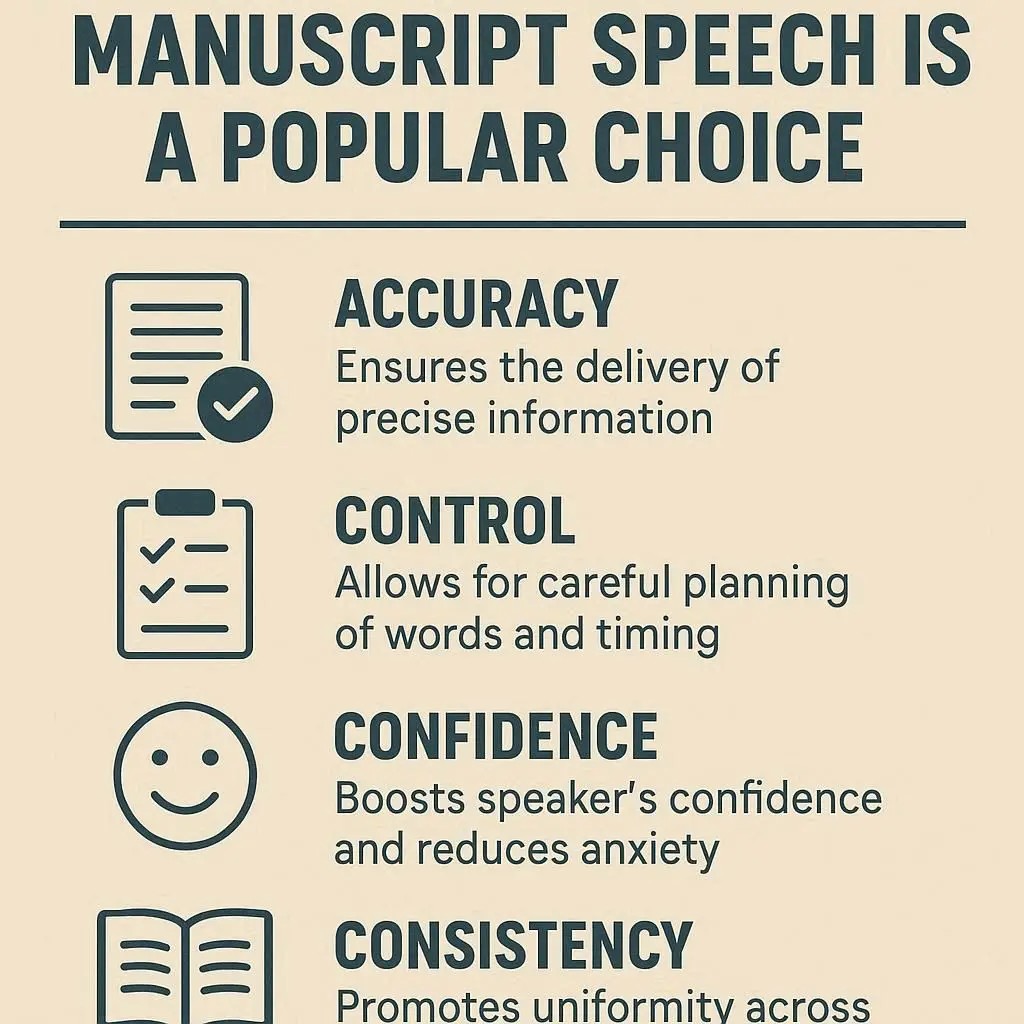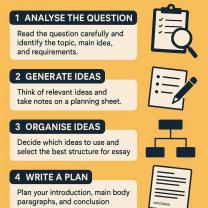Why is the manuscript speech a popular choice for speeches?
Why the Manuscript Speech Is a Popular Choice
A manuscript speech is one where the speaker reads the speech word-for-word from a written document. This approach is widely used in professional, political, and formal settings.
1. Ensures Accuracy
Precise wording: The speaker can communicate exact facts, quotes, or statistics without mistakes.
Avoids misinterpretation: Critical for technical, legal, or political speeches where accuracy is essential.
2. Reduces Risk of Forgetting
Having the full speech in front of you prevents memory lapses.
Ideal for long, detailed, or complex speeches that are difficult to memorize.
3. Maintains Professionalism
Helps speakers stay formal and structured, avoiding off-the-cuff errors.
Frequently used by politicians, CEOs, and news anchors to maintain credibility.
4. Controls Timing and Flow
The speaker can exactly time the speech, making it suitable for events with strict schedules.
Enables careful pacing and emphasis, ensuring key points are delivered effectively.
5. Reduces Anxiety for Some Speakers
Having a manuscript can boost confidence for those uncomfortable speaking spontaneously.
Provides a safety net, making it easier to handle high-pressure situations like public addresses or broadcasts.
Key Takeaways
Manuscript speeches are popular because they guarantee accuracy, maintain professionalism, control timing, and reduce anxiety.
They are especially suited for formal, technical, or high-stakes occasions.
Here’s a comparison table of different speech types, including manuscript, memorized, impromptu, and extemporaneous speeches, with their pros and cons:
| Speech Type | Description | Advantages | Disadvantages | Best Use Cases |
|---|---|---|---|---|
| Manuscript Speech | Speaker reads the speech word-for-word from a written document. | - Guarantees accuracy and precision - Controls timing and pacing - Reduces anxiety for some speakers | - Can sound less natural - Limited eye contact - Less flexible for audience interaction | Formal events, political speeches, technical presentations, news broadcasts |
| Memorized Speech | Speaker memorizes the entire speech and delivers it without notes. | - Allows eye contact and gestures - Appears polished and confident | - Risk of forgetting lines - Can feel rigid if interrupted | Award presentations, ceremonial speeches, short scripted addresses |
| Impromptu Speech | Delivered without preparation, usually spontaneous. | - Shows adaptability and quick thinking - Can feel natural and genuine | - Higher risk of errors - Limited structure and detail | Q&A sessions, classroom discussions, casual events |
| Extemporaneous Speech | Speaker prepares key points and delivers speech with limited notes. | - Balanced between structure and spontaneity - Encourages natural delivery - Can adapt to audience reactions | - Requires practice - May occasionally stumble on wording | Professional presentations, business meetings, lectures, conferences |
Manuscript speeches are popular due to their precision and the control they offer over the message, especially in high-stakes situations.
Why the Manuscript Speech Is Popular
Manuscript speeches are highly favored in situations where precision and exact wording are paramount.
Official Statements: Political leaders, business executives, and news anchors often use manuscripts (or teleprompters) to deliver carefully crafted messages where every phrase may be scrutinized.
High-Stakes Events: At ceremonies, graduations, or public announcements, the stakes are high, and speakers want to ensure their message resonates and is remembered accurately.
Think of historical addresses like the Gettysburg Address, where every word was meticulously chosen. Complex or Sensitive Topics: When dealing with intricate data, legal information, or emotional subjects, a manuscript provides the security of having the exact words to convey the message responsibly and effectively.
Time Management: Having a fully written script allows speakers to meticulously time their delivery, ensuring they stay within allotted time limits and cover all essential points.
Benefits of Using a Manuscript for Speeches
The advantages of delivering a speech from a manuscript are significant, offering a sense of control and reducing potential pitfalls.
Accuracy and Precision: The primary benefit is the exact repetition of original words.
This is invaluable when the specific language matters, such as quoting statistics, legal texts, or delivering formal policy statements. Control over Language: Speakers can carefully select words, rework phrases, and polish the speech with the help of others, ensuring the highest quality of expression. This allows for the use of advanced linguistic techniques and specific emotional tones.
Reduced Anxiety: For many, the security of having the entire text in front of them significantly reduces nervousness.
If a speaker gets lost or flustered, they can easily glance down to find their place and get back on track. Consistency: When a speech needs to be delivered multiple times, a manuscript ensures consistency in content and length.
Distribution of Content: It's easier to distribute copies of the address to news representatives, attendees, or for archival purposes.
Tips for Writing an Effective Manuscript Speech
Writing a manuscript speech requires a different approach than writing an essay or an extemporaneous outline. The goal is to make it easy to read aloud while sounding conversational.
Write for the Ear, Not the Eye: Use spoken language rather than overly formal written language. Employ shorter, simpler sentences and avoid convoluted phrases that can be difficult to deliver naturally.
Use Conversational Tone: Imagine you're speaking to an individual or a small group. This helps create a more engaging and authentic delivery.
Format for Easy Reading:
Large Print: Use a large, easy-to-read font (e.g., 14-16 pt or larger) with ample spacing (double or triple-spaced).
Wide Margins: Provide generous margins to make the text less dense and allow for annotations.
Short Lines/Phrases: Break sentences into shorter lines or phrases, much like poetry, so you can take in several words at a glance without losing your place.
Bold Key Points/Pauses: Use bolding for emphasis on important words or ideas.
Use symbols like ///or...to indicate intentional pauses.Page Numbers: Number your pages clearly.
Single-Sided: Print on only one side of the paper and do not staple pages, making them easier to turn silently.
"Score" Your Speech: Mark your manuscript with cues for delivery, such as underlining words for emphasis, drawing arrows to indicate vocal inflections (raise/lower voice), and noting where to pause.
Thorough Research: Even with a manuscript, a deep understanding of your topic strengthens your confidence and allows for more natural delivery.
Delivery Techniques for Manuscript Speeches
The key to a successful manuscript speech lies in its delivery, making it sound natural and engaging rather than simply read.
Practice Extensively: Rehearse the speech multiple times (at least 5-7 times) until you are so familiar with it that you can glance down, absorb a phrase, and deliver it while maintaining eye contact with the audience.
Maintain Eye Contact: Actively look at different audience members.
Avoid gluing your eyes to the page. Practice lifting your gaze from the manuscript at the end of a thought or sentence and connecting with the audience before looking back down. Vocal Variety: Avoid a monotone delivery.
Vary your pitch, pace, and volume to convey emotion and emphasize key points. Use pauses effectively to create impact and allow ideas to sink in. Natural Body Language and Gestures: Even when reading, use appropriate hand gestures, facial expressions, and body movement to convey energy and enthusiasm.
Don't be constrained by the manuscript; let your personality come through. Pace Yourself: Nervousness can lead to rushing. Consciously slow down your speaking rate, especially at important junctures.
Writing "SLOW" or "PAUSE" in your margins can serve as a reminder. Use a Lectern or Teleprompter: These tools help manage the manuscript. Teleprompters, in particular, allow for seamless eye contact with the camera or audience, giving the impression of an extemporaneous speech.
Common Mistakes to Avoid When Using Manuscripts
While offering many advantages, manuscript speeches also present potential pitfalls if not handled carefully.
Lack of Eye Contact: This is the most common mistake. Speakers often become engrossed in reading, losing connection with the audience, which makes the speech feel impersonal and disengaging.
Monotonous Delivery: Reading verbatim without vocal variety, gestures, or enthusiasm can make a speech sound dull, flat, and like an "essay with legs" rather than a dynamic presentation.
Poor Formatting: Using small fonts, crowded pages, or double-sided printing makes it difficult to read smoothly, leading to stumbling and a further reduction in eye contact.
Insufficient Practice: Assuming that having a full script means less practice is a critical error.
Manuscript speeches often require more practice to achieve a natural, conversational delivery. Being Tied to the Lectern: While a manuscript can anchor you, it shouldn't prevent all movement or interaction. Some speakers can hold a rigid folder or use a teleprompter to allow for more freedom of movement.
Not Personalizing the Language: If a speech is written by someone else, failing to adapt it to your own speaking style can make it sound inauthentic.
Failing to Adapt to the Audience: While a manuscript provides precision, rigid adherence without any flexibility to acknowledge audience reactions or an unexpected event can make the speaker seem disconnected.












